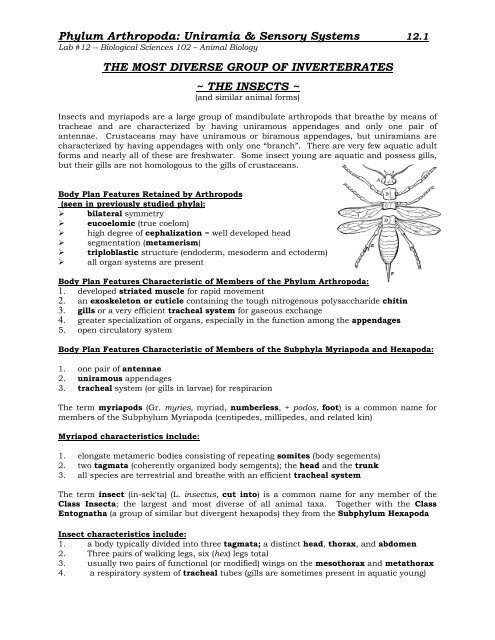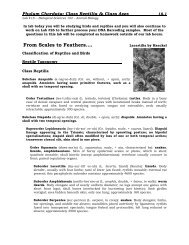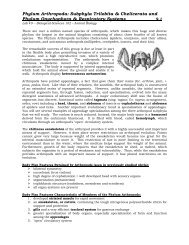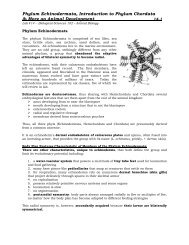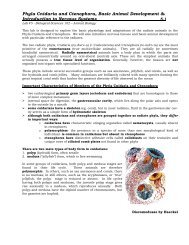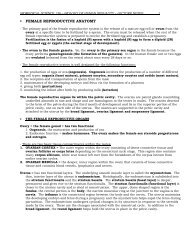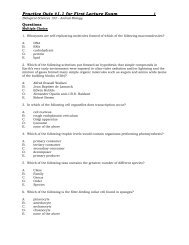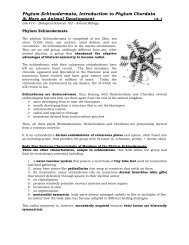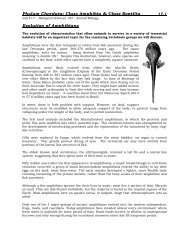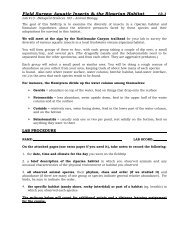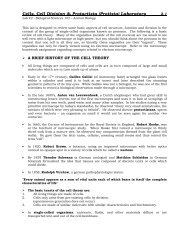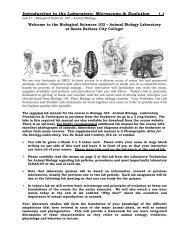Phylum Arthropoda: Uniramia & Sensory Systems ... - Biosciweb.net
Phylum Arthropoda: Uniramia & Sensory Systems ... - Biosciweb.net
Phylum Arthropoda: Uniramia & Sensory Systems ... - Biosciweb.net
You also want an ePaper? Increase the reach of your titles
YUMPU automatically turns print PDFs into web optimized ePapers that Google loves.
<strong>Phylum</strong> <strong>Arthropoda</strong>: <strong>Uniramia</strong> & <strong>Sensory</strong> <strong>Systems</strong> 12.1<br />
Lab #12 -- Biological Sciences 102 – Animal Biology<br />
THE MOST DIVERSE GROUP OF INVERTEBRATES<br />
~ THE INSECTS ~<br />
(and similar animal forms)<br />
Insects and myriapods are a large group of mandibulate arthropods that breathe by means of<br />
tracheae and are characterized by having uniramous appendages and only one pair of<br />
antennae. Crustaceans may have uniramous or biramous appendages, but uniramians are<br />
characterized by having appendages with only one “branch”. There are very few aquatic adult<br />
forms and nearly all of these are freshwater. Some insect young are aquatic and possess gills,<br />
but their gills are not homologous to the gills of crustaceans.<br />
Body Plan Features Retained by Arthropods<br />
(seen in previously studied phyla):<br />
‣ bilateral symmetry<br />
‣ eucoelomic (true coelom)<br />
‣ high degree of cephalization = well developed head<br />
‣ segmentation (metamerism)<br />
‣ triploblastic structure (endoderm, mesoderm and ectoderm)<br />
‣ all organ systems are present<br />
Body Plan Features Characteristic of Members of the <strong>Phylum</strong> <strong>Arthropoda</strong>:<br />
1. developed striated muscle for rapid movement<br />
2. an exoskeleton or cuticle containing the tough nitrogenous polysaccharide chitin<br />
3. gills or a very efficient tracheal system for gaseous exchange<br />
4. greater specialization of organs, especially in the function among the appendages<br />
5. open circulatory system<br />
Body Plan Features Characteristic of Members of the Subphyla Myriapoda and Hexapoda:<br />
1. one pair of antennae<br />
2. uniramous appendages<br />
3. tracheal system (or gills in larvae) for respirarion<br />
The term myriapods (Gr. myries, myriad, numberless, + podos, foot) is a common name for<br />
members of the Subphylum Myriapoda (centipedes, millipedes, and related kin)<br />
Myriapod characteristics include:<br />
1. elongate metameric bodies consisting of repeating somites (body segements)<br />
2. two tagmata (coherently organized body semgents); the head and the trunk<br />
3. all species are terrestrial and breathe with an efficient tracheal system<br />
The term insect (in-sek'ta) (L. insectus, cut into) is a common name for any member of the<br />
Class Insecta; the largest and most diverse of all animal taxa. Together with the Class<br />
Entognatha (a group of similar but divergent hexapods) they from the Subphylum Hexapoda<br />
Insect characteristics include:<br />
1. a body typically divided into three tagmata; a distinct head, thorax, and abdomen<br />
2. Three pairs of walking legs, six (hex) legs total<br />
3. usually two pairs of functional (or modified) wings on the mesothorax and metathorax<br />
4. a respiratory system of tracheal tubes (gills are sometimes present in aquatic young)
<strong>Phylum</strong> <strong>Arthropoda</strong>: <strong>Uniramia</strong> & <strong>Sensory</strong> <strong>Systems</strong> 12.2<br />
Lab #12 -- Biological Sciences 102 – Animal Biology<br />
<strong>Phylum</strong> <strong>Arthropoda</strong>: Myriapod and Hexapod Classification<br />
Subphylum Myriapoda (Gr. myrios, countless, + podos, feet). The myriapods.<br />
Class Chilopoda (ki-lop'o-da) (Gr. cheilos, lip, + podos, foot). The centipedes.<br />
1. characterized by an elongate and dorsoventrally flat body plan<br />
2. only one pair of appendages per somite<br />
3. the first pair of legs are modified into venomous forcipules (forceps-like pincers)<br />
4. almost exclusively carnivorous taxa, predating mostly on smaller invertebrates.<br />
Class Diplopoda (di-plop'o-da) (Gr. diploos, double, + podos, feet). The millipedes.<br />
1. characterized by an elongate and subcylindrical body plan<br />
2. each “diplo-segment” has two pairs of legs (versus the one pair found in centipedes)<br />
3. largely slow moving detritivores capable of chemical defense through the secretion of<br />
caustic substances or mechanical defense by curling into a ball<br />
Subphylum Hexapoda<br />
Class Insecta (in-sek'ta) (L. insectus, cut into).<br />
The insects - more than one million species<br />
Subclass Archaeognatha (Monocondylia)<br />
Order Archaeognatha – the jumping bristle-tails<br />
Subclass Dicondylia<br />
Order Zygentoma – the silverfish.<br />
Subclass Pterygota – The winged insects<br />
- 97% of all insects are a member of this subclass -<br />
Insect growth and metamorphosis<br />
The immature and adult forms of most insects are strikingly different in the both their<br />
morphology and ecology, this is evolutionarily selectable as it allows the young to occupy a<br />
different ecological niche from the adult and thus reduce competition between<br />
generations. Most immature insects lack wings and must go through a series of molts<br />
before a final metamorphosis occurs and the flighted sexually mature adult (imago)<br />
emerges.<br />
Holometabolous (complete) metamorphosis: the young (referred to as<br />
larva) are strikingly different from the adults and must undergo a period<br />
of massive morphological changes, usually occuring in a pupa (also<br />
called a chrysalis or a cocoon) These species usually have four distinct<br />
life stages; egg, larva, pupa, and adult, These species are referred to as<br />
endopterygotes as their wings develop internally. (Endopterygota used<br />
to be an Infraclass in the Subclass Neoptera and although it has since<br />
been dissolved its morphological description remains true).<br />
Hemimetabolous (incomplete) metamorphosis: the young (referred to<br />
as a nymph or naiads) more or less resemble miniature adults (though<br />
wingless). Nymphs will undergo a series of molts to become 1 st , 2 nd , 3 rd<br />
(etc) instars before one final molt after which they emerge as an adult<br />
imago. These species are referred to as exopterygotes as their wings<br />
develop externally, these immature wings can be seen as small “wing<br />
pads” on developing larva. (Exopterygota used to be an Infraclass in<br />
the Subclass Neoptera and although it has since been dissolved its<br />
morphological description remains true).
<strong>Phylum</strong> <strong>Arthropoda</strong>: <strong>Uniramia</strong> & <strong>Sensory</strong> <strong>Systems</strong> 12.3<br />
Lab #12 -- Biological Sciences 102 – Animal Biology<br />
Characterization of Winged Insect Taxonomy<br />
Note: the following insect orders are exopterygotes; their wings develop externally and they<br />
display hemimetabolous (incomplete) metamorphosis in which the young resemble<br />
smaller adults and grow by molting.<br />
Subclass Pterygota<br />
Infraclass Paleoptera - “ancient winged” insects (cannot fold wings over abdomen)<br />
Order Ephemeroptera - mayflies<br />
Order Odonata - dragonflies and damselflies<br />
Infraclass Neoptera - “new winged” insects (capable of folding wings over abdomen)<br />
Order Orthopera - crickets, grasshoppers and katydids<br />
Order Dermaptera - earwigs<br />
Order Isoptera - termites<br />
Order Phasmatodea - walking sticks<br />
Order Dictyoptera - mantids and cockroaches<br />
Suborder Mantodea - mantids such as the praying mantis<br />
Suborder Blattaria - cockroaches<br />
Order Pthiraptera - sucking and biting lice<br />
Suborder Anoplura - sucking lice on humans (eg. head lice and pubic lice)<br />
Suborder Amblycera – biting lice on birds and mammals<br />
other minor suborders contain sucking/chewing lice on other mammals<br />
Order Hemiptera - true bugs<br />
Family Belostomatidae - toe biters and water scorpions<br />
Family Gerridae - water striders<br />
Family Corixidae - water boatment<br />
Family Lygaeidae - seed bugs<br />
Order Embiidina - web-spinners<br />
Order Grylloblattodea - ice crawlers, ice bugs<br />
Order Thysanoptera - thrips, corn flies, thunder flies<br />
Order Mecoptera - scorpion flies, hanging flies<br />
Order Plecoptera - stone flies<br />
Order Psocoptera - book lice<br />
Order Mantophasmatodea - rock crawlers and gladiators<br />
Note: the following insect orders are endopterygotes; their wings develop internally and they<br />
display holometabolous (complete) metamorphosis in which the young enters a pupation<br />
state to gain the adult form.<br />
Subclass Pterygota<br />
Infraclass Neoptera - “new winged” insects<br />
Order Coleoptera - beetles (300,000+ species)<br />
Order Diptera - true flies<br />
Order Trichoptera - caddis flies<br />
Order Lepidoptera - butterflies, moths, skippers, and related kin<br />
Order Hymenoptera - bees, ants, and wasps<br />
Order Neuroptera - lacewings and their allies<br />
Order Raphidioptera - snakeflies<br />
Order Megaloptera - alderflies, dobsonflies, and fishflies<br />
Order Strepsiptera - twisted winged parasites
<strong>Phylum</strong> <strong>Arthropoda</strong>: <strong>Uniramia</strong> & <strong>Sensory</strong> <strong>Systems</strong> 12.4<br />
Lab #12 -- Biological Sciences 102 – Animal Biology<br />
Insect Flight Adaptations<br />
Although some insect species are secondarily wingless (such as ants and termites) most insect<br />
species have two pairs of fully developed or modified wings; one pair on the metathorax, one<br />
pair on the mesothorax and never a pair on the prothorax. Wings are highly diverse<br />
appendages and often differ significantly between insect orders.<br />
Direct Flight Muscles<br />
Evolutionarily ancient insect orders such as the odonatids<br />
(dragonflies and damselflies), ephemeropterans<br />
(mayflies), and dictyopterans (cockroaches and mantids)<br />
utilize a basic mechanical system in which thoracic flight<br />
muscles attach directly to the base of the wings, which flex<br />
up and down on a single hinge. Direct flight muscles are<br />
not capable of very high frequency wing beats.<br />
Indirect Flight Muscles<br />
Most other winged insect orders utilize an evolutionarily<br />
more advanced system of indirect flight muscles in which<br />
the flexing of perpendicular ventrodorsal and longitudinal<br />
muscles deform the thorax and cause the wings to flex up<br />
and down as they rotate on a hinge and fulcrum type<br />
system. These muscles do not associate with the wings<br />
and flight direction is controlled by minor direct flight<br />
muscles control the direction and angle of the wings.<br />
Synchronous Flight<br />
All direct flight muscles and some indirect flight muscles beat in a synchronous fashion,<br />
that is, each muscle only contracts once for every nerve impulse. As neurons have a<br />
refractory period that limits the frequency in their firing, synchronous flight muscles<br />
likewise have an upper limit on how quickly they beat (usually less than 50 beats per<br />
second). Examples include butterflies, dragonflies, and grasshoppers.<br />
Asynchronous Flight<br />
The layout of indirect flight muscles, allows for a positive feedback system in which<br />
wings continue to beat between neuronal refractory periods. Since circular and<br />
longitudinal muscles function by alternately stretching and compressing the thorax<br />
(instead of connecting straight to the wings), they also alternately stretch each other.<br />
The contraction of one muscle group stretches the opposing muscle group and<br />
stimulates a contraction in that group, thus, wing beats are said to become<br />
asynchronous as each nerve impulse may stimulate several wings beats. Extremely<br />
high wing beat frequencies (as high as 1,000+ beats per second in some flies) can be<br />
achieved with this system. Examples include bees, flies, and wasps.<br />
Tracheal System<br />
The cellular exchange of oxygen and carbon dioxide in insects is facilitated<br />
by a tracheal system of open tubes and air pockets that deliver gasses<br />
directly to the cells. Tracheal tubes originate as invaginations of the insects<br />
exoskeleton called spiracles, and terminate at individual cells. This<br />
ventilation system is all topologically exterior to the insect and is shed with<br />
each molt. Ventilation can be passive but is usually facilitated by muscular<br />
contractions of the abdomen, forcing air in and out of the tracheal system.<br />
Unlike higher vertebrates, insects do not transport oxygen in their<br />
hemolymph (blood), this is one of the major limiting factors to their size.
<strong>Phylum</strong> <strong>Arthropoda</strong>: <strong>Uniramia</strong> & <strong>Sensory</strong> <strong>Systems</strong> 12.5<br />
Lab #12 -- Biological Sciences 102 – Animal Biology<br />
<strong>Sensory</strong> <strong>Systems</strong> – Specialized <strong>Sensory</strong> Cells & Organs<br />
<strong>Sensory</strong> Receptor Cells<br />
These cells carry information to ganglia or the central nervous system via sensory<br />
neurons<br />
‣ thermoreceptors = detect either heat or cold<br />
‣ mechanoreceptors = detect mechanical changes, ie touch, pressure, muscle stretch,<br />
sound, etc.<br />
‣ hair cells = detect sound waves and fluid movement for hearing and equilibrium. These are<br />
found in the organ of Corti and semicircular canals of the inner ear as well as the neuromast<br />
cells of the lateral line system in fishes. The statoliths used by many arthropods for<br />
equilibrium (balance) contains hair cells.<br />
‣ stretch receptors = monitor changes in muscle length and activity. Stretch receptors<br />
modulate stretch reflexes that maintain optimal resting muscle length by resisting passive<br />
changes in muscle length (e.g. patellar tendon stretch reflex). The optimal resting muscle<br />
length is the length at which the muscle is the strongest.<br />
‣ chemoreceptors = detect odor (by the nose, antennae, etc.) and taste (by the tongue, feet,<br />
etc.). Chemoreceptors also detect changes in blood chemistry such as changes in carbon<br />
dioxide and oxygen in the blood that regulate the rate of respiration.<br />
‣ Photoreceptors (eg. rods & cones) = detect<br />
light. The eyespots in flatworms, the ocelli and<br />
ommatidia (compound eye) of arthropods and retina<br />
of many animals contains photoreceptors. The<br />
wavelength of light detected depends on the<br />
organism. Snakes can detect visible and infrared<br />
light (heat). Humans can only detect visible light.<br />
Some insects can see in the ultraviolet portion of the<br />
electromag<strong>net</strong>ic spectrum.<br />
‣ nociceptors (pain receptors) = sense and<br />
modulate pain response. Indicates danger or injury<br />
Your instructor will draw a simple reflex arc on the board to describe the integration between<br />
the sensory nervous system, central processing/integration in the cerebral ganglia or central<br />
nervous system and the motor system. This is basically how a stimulus causes a response<br />
in an animal. Draw this reflex arc on page 12.20 at the end of the lab.<br />
Ideas important in Vertebrates (and maybe invertebrates)<br />
sensation = a “feeling” or general awareness of stimuli resulting from sensory information<br />
entering the central nervous system (brain and spinal cord)<br />
perception = the brain’s meaningful interpretation, or conscious understanding of sensory<br />
information
<strong>Phylum</strong> <strong>Arthropoda</strong>: <strong>Uniramia</strong> & <strong>Sensory</strong> <strong>Systems</strong> 12.6<br />
Lab #12 -- Biological Sciences 102 – Animal Biology<br />
LAB PROCEDURE<br />
NAME:<br />
LAB SCORE:<br />
Observation of Living & Displayed Specimens<br />
‣ Use the textbook and Inter<strong>net</strong> to help you answer the questions – you may<br />
not be able to determine the answers by only viewing the specimens.<br />
Subphylum Myriapoda<br />
Class Chilopoda<br />
‣ As available, observe one of the chilopod (centipede) specimens and answer the<br />
following questions using the Inter<strong>net</strong> as a reference.<br />
‣ Record the descriptive information requested at the end of the lab for this species.<br />
Centipedes, or "hundred-leggers," are active predators that live in moist places under logs,<br />
stones, and bark, where they feed on worms, larvae, and insects. Note the general shape of the<br />
body and arrangement of segments and appendages.<br />
‣ Is the body circular or flattened in cross section<br />
Some species have simple ocelli; others have large, faceted eyes resembling the compound eyes<br />
of insects.<br />
‣ What is the function of the ocelli in arthropods<br />
Chilopods have antennae; a labrum, anterior to the mouth; mandibles and first<br />
maxillae, lateral to the mouth; and second maxillae, bearing a long palp and a short labial<br />
portion just posterior to the mouth (see diagrams in the lab).<br />
The first trunk appendages are the prehensile maxillipeds, each bearing a terminal poison<br />
fang.<br />
‣ Do the rest of the trunk segments bear legs<br />
The last segment bears the gonopores, and the anus is located on a short telson. In Lithobius<br />
they are located near the bases of the legs. In Scolopendra the spiracles are located more<br />
dorsally and are present on alternate segments.<br />
‣ What is the function of the spiracles in centipedes
<strong>Phylum</strong> <strong>Arthropoda</strong>: <strong>Uniramia</strong> & <strong>Sensory</strong> <strong>Systems</strong> 12.7<br />
Lab #12 -- Biological Sciences 102 – Animal Biology<br />
Subphylum Myriapoda<br />
Class Diplopoda<br />
‣ As available, observe one of the diplopod (millipede) specimens and answer the<br />
following questions using the Inter<strong>net</strong> as a reference.<br />
‣ Record the descriptive information requested at the end of the lab for this species.<br />
Millipedes, or "thousand-foot worms," are found throughout the world, usually hiding in damp<br />
woods under bark, leaves, rocks, and logs. They are herbivorous, feeding on decaying wood or<br />
leaves. Their most distinguishing feature is the presence of diplosegments, which are double<br />
trunk segments probably derived from the fusion of two single segments and each bearing two<br />
pairs of legs. The name "Diplopoda" comes from Greek diploos, double, and pous, podos, foot.<br />
The gonopores open on the third trunk segment at the bases of the legs.<br />
‣ How does this compare with the centipede<br />
The dorsal overlapping of the exoskeletal plates provides full protection for the animal, even<br />
when rolled into a ball. Each of the diplosegments has two pairs of spiracles.<br />
‣ Are there appendages on the first trunk segments<br />
‣ How many pairs on the next three segments<br />
Subphylum Hexapoda<br />
Class Insecta<br />
‣ Observe the various insect specimens on<br />
display, taking particular note of the order to which<br />
each insect belongs.<br />
‣ Record the descriptive information requested at<br />
the end of the lab for each order.<br />
Among the chief characteristics of insects are three pairs of walking legs; one pair of antennae;<br />
a body typically divided into head, thorax, and abdomen; and a respiratory system of tracheal<br />
tubes. Most insects are also provided with one or two pairs of wings. Their sense organs are<br />
often specialized and perhaps account for much of their success in the competition for<br />
ecological niches. Most insects are less than 2.5 cm long, but they range from 1 mm to 20 cm,<br />
with the largest insects usually living in tropical areas. A grasshopper has a fairly typical<br />
insect body plan. A honey bee, on the other hand, has become specialized for particular<br />
conditions. Not only is its morphology modified for special functions and adaptations, but it is<br />
a social insect in which patterns of group organization involve different types of individuals and<br />
division of labor.
<strong>Phylum</strong> <strong>Arthropoda</strong>: <strong>Uniramia</strong> & <strong>Sensory</strong> <strong>Systems</strong> 12.8<br />
Lab #12 -- Biological Sciences 102 – Animal Biology<br />
Subphylum Hexapoda<br />
Class Insecta<br />
Order Dictyoptera<br />
Suborder Blattaria<br />
Study of a Living Cockroach<br />
‣ Each group of students should look at one of the living cockroach specimens.<br />
‣ We will perform the observations below together as a class.<br />
‣ Does your cockroach exhibit positive or negative phototaxis What is phototaxis<br />
‣ Briefly describe the righting response in your cockroach.<br />
‣ Is this species capable of flight Are there cockroaches that do not fly<br />
‣ How does the cockroach breathe (How does it get air into its body)<br />
‣ What are some common foods for cockroaches<br />
‣ Do not euthanize your cockroach.<br />
‣ Please return them live to the container provided.
<strong>Phylum</strong> <strong>Arthropoda</strong>: <strong>Uniramia</strong> & <strong>Sensory</strong> <strong>Systems</strong> 12.9<br />
Lab #12 -- Biological Sciences 102 – Animal Biology<br />
DISSECTION<br />
Subphylum Hexapoda<br />
Class Insecta<br />
Order Orthoptera<br />
Romalea sp. (Lubber Grasshopper)<br />
Use a dissecting scope for your investigation.<br />
Obtain one preserved grasshopper specimen for each two students.<br />
‣ Examine the external anatomy of the grasshopper on both the dorsal and<br />
ventral sides and be able to identify the structures described below.<br />
Locate three tagmata: head, thorax, and abdomen<br />
‣ Is the grasshopper segmented throughout, or is segmentation more apparent in certain<br />
regions of the body If so, where is segmentation more apparent.<br />
The chitinous exoskeleton is secreted by the underlying epidermis. It is composed of hard<br />
plates, called sclerites, which are bounded by sutures of soft cuticle.<br />
The Head of the Grasshopper<br />
The head of the grasshopper is freely movable. Notice the compound eyes, antennae, and<br />
three ocelli, one dorsal to the base of each antenna and one in the groove between them. Lift<br />
the movable, bilobed upper lip, or labrum (lip), and observe the toothed mandibles (jaws). The<br />
mouth contains a membranous hypopharynx for tasting food. The bilobed lower lip, or<br />
labium, is the result of the fusion of the second maxillae. The labium bears on each side a<br />
three-jointed labial palp. Between the mandible and labium are paired maxillae (jaws) each<br />
with a maxillary palp, flat lobe, and toothed jaw. Note how the mouthparts are adapted<br />
for biting and chewing.<br />
Generally, the insect head has four pairs of true appendages: antennae, mandibles,<br />
maxillae, and labium (fused second maxillae). There are at least six segments in the head<br />
region, although some of them are apparent only in the insect embryo.<br />
‣ After you have studied the rest of the external features, if time permits, you may<br />
use forceps and probing needles to carefully remove all the mouthparts and arrange them<br />
in their relative positions on a sheet of paper.<br />
Head Structures<br />
‣ compound eyes<br />
‣ antennae<br />
‣ three ocelli<br />
‣ antennae<br />
‣ labrum<br />
‣ labium (second maxillae)<br />
with labial palps<br />
‣ maxillae with maxillary<br />
palps<br />
‣ mandibles<br />
‣ hypopharynx
<strong>Phylum</strong> <strong>Arthropoda</strong>: <strong>Uniramia</strong> & <strong>Sensory</strong> <strong>Systems</strong> 12.10<br />
Lab #12 -- Biological Sciences 102 – Animal Biology<br />
Thorax of the Grasshopper<br />
The thorax is made up of three segments: prothorax, mesothorax, and metathorax, each<br />
bearing a pair of legs. The mesothorax and metathorax also bear a pair of wings.<br />
Spiracles (external openings of the insect's tracheal system) are located above the legs in<br />
the mesothorax and metathorax. Note the leathery forewings (on the mesothorax) and<br />
the membranous hindwings (on the metathorax).<br />
‣ Which set of wings is more useful for actual flight<br />
‣ What appears to be the chief function of the forewings<br />
The small veins in the wings, or tracheal tubes, are used by entomologists in the<br />
identification and classification of insects. These transport air to cells in the wings.<br />
Examine the grasshopper's legs and identify the basal coxa (L., hip); small trochanter<br />
(Gr., ball of hip joint); large femur; slender, spiny tibia; and five-jointed tarsus with two<br />
claws and a terminal pad, the arolium<br />
Which pair of legs is most specialized, and for what function<br />
Thoracic Structures<br />
‣ prothorax<br />
‣ mesothorax<br />
‣ metathorax<br />
‣ two pairs of wings<br />
‣ tracheal tubes in wings<br />
Leg Structures<br />
‣ basal coxa<br />
‣ trochanter<br />
‣ femur<br />
‣ tibia<br />
‣ tarsus<br />
‣ claws
<strong>Phylum</strong> <strong>Arthropoda</strong>: <strong>Uniramia</strong> & <strong>Sensory</strong> <strong>Systems</strong> 12.11<br />
Lab #12 -- Biological Sciences 102 – Animal Biology<br />
Abdomen of the Grasshopper<br />
There are 11 segments in the abdomen of the grasshopper. Notice the large tympanum,<br />
the organ of hearing, one located on each side of the first abdominal segment.<br />
‣ On which of the abdominal segments are the paired spiracles located<br />
In both sexes, segments 2 to 8 are similar and unmodified, and segments 9 and 10 are<br />
partially fused.<br />
The eleventh segment forms the genitalia (secondary sex organs). On each side behind the<br />
tenth segment is a projection, the cercus (pl. cerci; Gr. kerkos, tail). In females the posterior<br />
end of the abdomen is pointed and consist of two pairs of plates, with a smaller pair between,<br />
with the whole forming the ovipositior. Between the plates is the opening of the oviduct.<br />
The end of the abdomen in males is rounded.<br />
What is the sex of your grasshopper specimen<br />
Abdominal Structures<br />
‣ tympanum<br />
‣ fusion of segments 9 & 10 (if visible)<br />
‣ cercus<br />
‣ in females: the ovipositor (if visible)<br />
‣ Your instructor will be reviewing the grasshopper structures with you under the<br />
instructor’s dissecting scope.<br />
‣ You should be able to identify the structures listed in preparation for the<br />
invertebrate lab practical.<br />
‣ Place the grasshopper and all dissected parts into the waste container provided.<br />
‣ Rinse your dissecting tray and clean your supplies and return them.
<strong>Phylum</strong> <strong>Arthropoda</strong>: <strong>Uniramia</strong> & <strong>Sensory</strong> <strong>Systems</strong> 12.12<br />
Lab #12 -- Biological Sciences 102 – Animal Biology<br />
Displayed Specimens Data<br />
Subphylum Myriapoda<br />
Class Chilopoda (centipedes)<br />
Scientific name (if known):<br />
Common name:<br />
Notes & observations to help you remember and distinguish this class:<br />
Subphylum Myriapoda<br />
Class Diplopoda (millipedes)<br />
Scientific name (if known):<br />
Common name:<br />
Notes & observations to help you remember and distinguish this class:
<strong>Phylum</strong> <strong>Arthropoda</strong>: <strong>Uniramia</strong> & <strong>Sensory</strong> <strong>Systems</strong> 12.13<br />
Lab #12 -- Biological Sciences 102 – Animal Biology<br />
Subphylum Hexapoda<br />
Class Insecta<br />
Subclass Dicondylia<br />
Order Zygentoma (silverfish)<br />
Scientific name (if known):<br />
Common name: silverfish<br />
Unique structures or features this subclass:<br />
Subphylum Hexapoda<br />
Class Insecta<br />
Subclass Pterygota<br />
Insect Orders<br />
Use the taxonomic key provided at the end of the lab to help you review the difference<br />
between these various insect orders<br />
Order Ephemeroptera (mayflies)<br />
Unique structures or features this order:<br />
Type of mouthparts & typical food:<br />
Order Odonata (dragonflies & damselflies)<br />
Unique structures or features this order:<br />
Type of mouthparts & typical food:
<strong>Phylum</strong> <strong>Arthropoda</strong>: <strong>Uniramia</strong> & <strong>Sensory</strong> <strong>Systems</strong> 12.14<br />
Lab #12 -- Biological Sciences 102 – Animal Biology<br />
Order Orthoptera (grasshoppers, crickets, katydids, etc.)<br />
Unique structures or features this order:<br />
Type of mouthparts & typical food:<br />
Order Dermaptera (earwigs)<br />
Unique structures or features this order:<br />
Type of mouthparts & typical food:<br />
Order Plecoptera (stoneflies)<br />
Unique structures or features this order:<br />
Type of mouthparts & typical food:<br />
Order Isoptera (termites)<br />
Unique structures or features this order:<br />
Type of mouthparts & typical food:
<strong>Phylum</strong> <strong>Arthropoda</strong>: <strong>Uniramia</strong> & <strong>Sensory</strong> <strong>Systems</strong> 12.15<br />
Lab #12 -- Biological Sciences 102 – Animal Biology<br />
Order Phthiraptera (lice)<br />
Suborder Amblycera (biting lice on birds and mammals)<br />
Unique structures or features this order:<br />
Type of mouthparts & typical food:<br />
Order Phthiraptera (lice)<br />
Suborder Anoplura (sucking lice on human/mammal hair – head/pubic)<br />
Unique structures or features this order:<br />
Type of mouthparts & typical food:<br />
Order Hemiptera (true bugs, cicadas, hoppers, aphids, scale insects, etc.)<br />
Unique structures or features this order:<br />
Type of mouthparts & typical food:<br />
Order Hemiptera (true bugs)<br />
Family Notinectidae (backswimmers)<br />
Family Corixidae (water boatman)<br />
Family Belostomoatidae (toe biters)<br />
Family Gerridae (water striders)<br />
Unique structures or features the Family Gerridae (water striders) specifically:<br />
Type of mouthparts & typical food:
<strong>Phylum</strong> <strong>Arthropoda</strong>: <strong>Uniramia</strong> & <strong>Sensory</strong> <strong>Systems</strong> 12.16<br />
Lab #12 -- Biological Sciences 102 – Animal Biology<br />
Order Neuroptera (dobsonflies, ant lions, lacewings)<br />
Unique structures or features this order:<br />
Type of mouthparts & typical food:<br />
Order Coleoptera (beetles, “fireflies”, weevils)<br />
Unique structures or features this order:<br />
Type of mouthparts & typical food:<br />
Order Lepidoptera (butterflies, moths)<br />
Unique structures or features this order:<br />
Type of mouthparts & typical food:<br />
Order Diptera (true Flies - one pair of wings, one pair of halteres for balance)<br />
Mosquitoes and House Flies among many others are different species of dipterans<br />
Unique structures or features this order:<br />
Type of mouthparts & typical food:
<strong>Phylum</strong> <strong>Arthropoda</strong>: <strong>Uniramia</strong> & <strong>Sensory</strong> <strong>Systems</strong> 12.17<br />
Lab #12 -- Biological Sciences 102 – Animal Biology<br />
Order Trichoptera (caddis flies)<br />
Unique structures or features this order:<br />
Type of mouthparts & typical food:<br />
Order Siphonaptera (fleas)<br />
Unique structures or features this order:<br />
Type of mouthparts & typical food:<br />
Order Hymenoptera (ants, bees, wasps)<br />
Unique structures or features this order:<br />
Type of mouthparts & typical food:<br />
Order Phasmatodea (stick insects or walking sticks)<br />
Unique structures or features this order:<br />
Type of mouthparts & typical food:
<strong>Phylum</strong> <strong>Arthropoda</strong>: <strong>Uniramia</strong> & <strong>Sensory</strong> <strong>Systems</strong> 12.18<br />
Lab #12 -- Biological Sciences 102 – Animal Biology<br />
Order Dictyoptera<br />
Suborder Mantodea (mantids such as the praying mantis)<br />
Unique structures or features this order:<br />
Type of mouthparts & typical food:<br />
Order Dictyoptera<br />
Suborder Blattaria (cockroaches)<br />
Unique structures or features this order:<br />
Type of mouthparts & typical food:<br />
Order Psocoptera (barklice and booklice)<br />
Unique structures or features this order:<br />
Type of mouthparts & typical food:<br />
Order Mecoptera (scorpionflies)<br />
Unique structures or features this order:<br />
Type of mouthparts & typical food:
<strong>Phylum</strong> <strong>Arthropoda</strong>: <strong>Uniramia</strong> & <strong>Sensory</strong> <strong>Systems</strong> 12.19<br />
Lab #12 -- Biological Sciences 102 – Animal Biology<br />
Homework – use the Inter<strong>net</strong> to assist you in answering these questions:<br />
‣ Briefly describe and/or draw a diagram to show the lifecycle of an insect that<br />
undergoes holometabolous metamorphosis (complete metamorphosis).<br />
‣ Briefly describe and/or draw a diagram to show the lifecycle of an insect that<br />
undergoes hemimetabolous metamorphosis (incomplete metamorphosis).<br />
‣ Briefly describe the caste system and various members of any typical ant colony.
<strong>Phylum</strong> <strong>Arthropoda</strong>: <strong>Uniramia</strong> & <strong>Sensory</strong> <strong>Systems</strong> 12.20<br />
Lab #12 -- Biological Sciences 102 – Animal Biology<br />
LABORATORY NOTES:<br />
DRAW A DIAGRAM OF A REFLEX ARC IN THE NERVOUS SYSTEM HERE:


